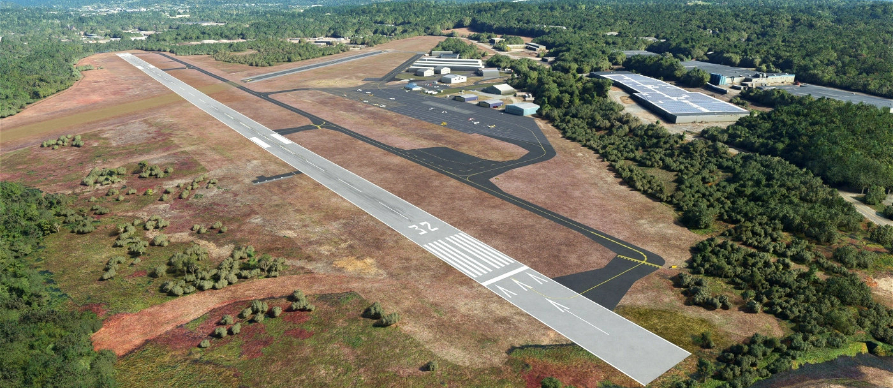
A Un-towered airport, is an airport without an operating control tower or air traffic control (ATC) unit. The vast majority of the world’s airports are un-towered. In the United States, there are close to 20,000 un-towered airports compared to approximately 500 airports with control towers
At these airports, the pilots who are operating in and around the airport coordinate takeoffs, landings, and other operations by using announcing their intentions and movements on a common radio frequency (CTAF) using specific procedures outlined by the FAA.
Traffic patterns, communication protocols, and right-of-way rules are established to ensure safety and efficient operations in the absence of air traffic control (ATC). It relies on a pilot’s situational awareness and communication skills to maintain safety in the airspace. Pilots operating at un-towered airports follow specific procedures to ensure safe and efficient operations.
Communication:
Pilots use the Common Traffic Advisory Frequency (CTAF) designated for the airport to self-announce their intentions and listen for other aircraft in the area.
The CTAF frequency is published on aeronautical charts and in the relevant chart supplement publication. You may also find the frequency in popular apps such as Foreflight, Garmin Pilot, Q EFB etc.
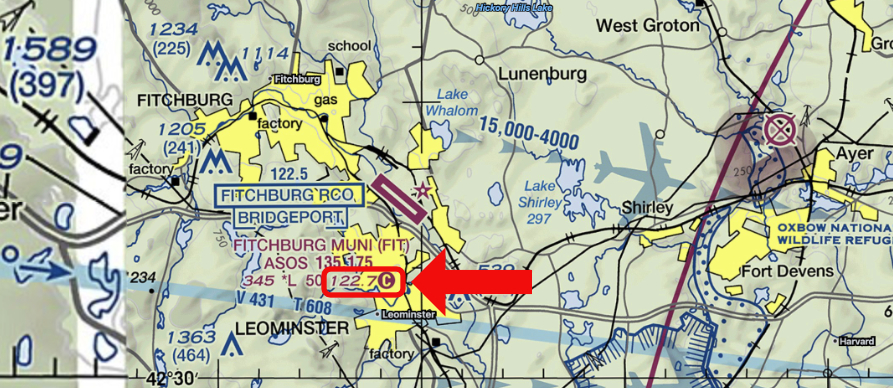
The un-towered airport you will be flying at will likely share the frequency with other un-towered airports! You should listen for calls made at the airport you are currently at eg. “Fitchburg Traffic” It is extremely important that when making radio transmissions begin your transmission with airport name + “traffic” e.g “Fitchburg Traffic” and end the transmission with the name of the airport e.g “Fitchburg”
Note: In uncontrolled airspace, pilots are not required to communicate on a radio, which means there may be aircraft operating without making radio calls! This emphasizes the importance of maintaining situational awareness and following visual flight rules (VFR) when flying in these areas. Pilots should always be vigilant for other aircraft and utilize visual scanning techniques.
Visual Scanning: Pilots must maintain a vigilant visual scan for other aircraft in the vicinity of the airport. Since there is no ATC providing separation, it is crucial to visually acquire and avoid other traffic. Adhere to standard practices for visual separation, such as maintaining altitude and using common traffic patterns when approaching airports. Always being alert and using visual scanning techniques can help enhance safety in such environments.
Traffic Pattern:
Pilots must adhere to a standard traffic pattern at the airport. Fly the traffic pattern the same way as you do at your home airport. Ensure you know the airport elevation so you fly the traffic pattern at the required 1000′ AGL altitude.
The standard traffic pattern is make left turns, but it may vary depending on local procedures. Make sure you check for the airport you will be flying to!
Communications in the pattern
Pilots announce their position and intentions on the CTAF to inform other pilots in the area.
The calls are made: turning crosswind, turning and on downwind, turning base, turning and on final, and exiting or entering a runway.
Examples:
- Initial call: When entering the traffic pattern, pilots announce their position, aircraft type, and intentions
(e.g.,”Fitchburg Traffic, Warrior 123AB, entering left downwind for Runway 32, Fitchburg”).
- Downwind call: When on the downwind leg of the traffic pattern, pilots announce their position and intentions.
(e.g., “Fitchburg Traffic, Warrior 123AB, left downwind, Runway 32, Fitchburg”).
- Base call: When turning onto the base leg of the traffic pattern, pilots announce their position.
(e.g., “Fitchburg Traffic, Warrior 123AB, turning left base, Runway 32, Fitchburg”).
- On Final call: When on final approach, pilots announce their position and intentions
(e.g., “Fitchburg Traffic, Warrior 123AB, final for Runway 32, full stop, Fitchburg”).
Notes on uncontrolled airport communications
- You are probably not alone out there, and the purpose of these calls is to make others aware, and for you to be aware of others. The best idea for safety is to keep your eyes open and be cognizant of your place in the pattern, and your turns in the pattern.
- None of these calls are legally mandatory, and there could very well be people in the pattern who don’t even have radios. It is always your responsibility to see and avoid other traffic, regardless of radio calls.
- Not all of these calls may be necessary, and in fact some examiners and experienced pilots prefer that people not jam up the airways with every single detail of their pattern. Use your judgment, and keep the calls short.
Right of Way
Pilots must adhere to right-of-way rules to avoid conflicts with other aircraft.
General right-of-way rules include giving way to aircraft on the right and yielding to aircraft on final approach.
Self-Announce Departures: Pilots announce their departure intentions on the CTAF before taxiing onto the runway and taking off. They provide their aircraft type, departure direction, and any pertinent information (e.g., “Fitchburg Traffic, Warrior 123AB, departing Runway 22, left crosswind departure, Fitchburg”).
It’s important to note that untowered airport procedures may vary depending on the specific airport and local regulations. Pilots should always consult the airport’s published information, such as the Chart Supplement, NOTAMs (Notice to Air Missions), and any other available resources for specific procedures and airport-specific considerations.
Flying into an uncontrolled airport
When flying in to an uncontrolled airport, start by getting the pertinent weather information, such as ASOS or AWOS (if it’s available).
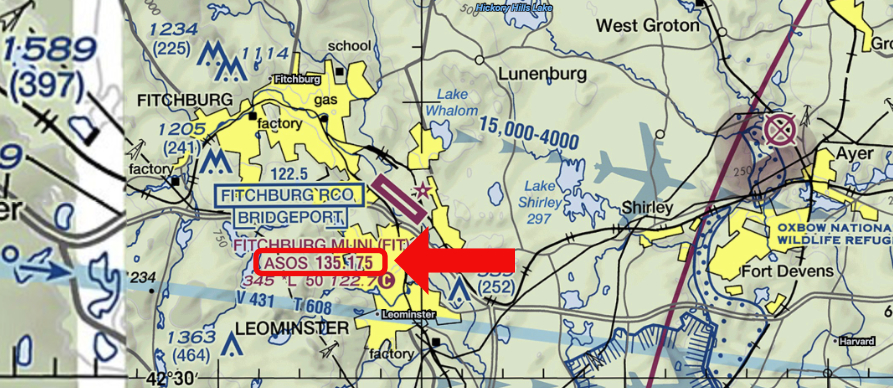
Depending on the prevailing winds – you can make a choice about which runway you will be landing on. Listening to the CTAF frequency will allow you to hear what runway other pilots are currently landing on.
You should plan to join the traffic pattern and fit into the flow of the existing traffic flying around the airport.
Monitoring aircraft movements (ADSB information) displayed on a chart (such as those in Foreflight running on an iPad) will allow you to see what runways are currently being used.
You may also make a radio call and talk to the airport’s UNICOM frequency. UNICOM is simply somebody sitting at the FBO desk waiting to fuel planes and listening to the radio to find out which runway is in use. This is called an “airport advisory”:
Example:
Pilot: Fitchburg UNICOM, Warrior 123AB, requests the active.
UNICOM: Active at Fitchburg is three-two.
From then on, you’re talking to other traffic in the area, in order that everyone be aware of each other. Call the traffic by “[City name] traffic.’ For uncontrolled airport communications, it’s still: YOU, ME, WHERE, WHAT, and then add to the end the city name again.
If you are approaching the airport from the same side as the downwind for the active runway, you should plan your flight path appropriately and maneuver to enter the downwind at a 45° angle. Once on the downwind fly the traffic pattern as you normally would at any other (towered) airport.
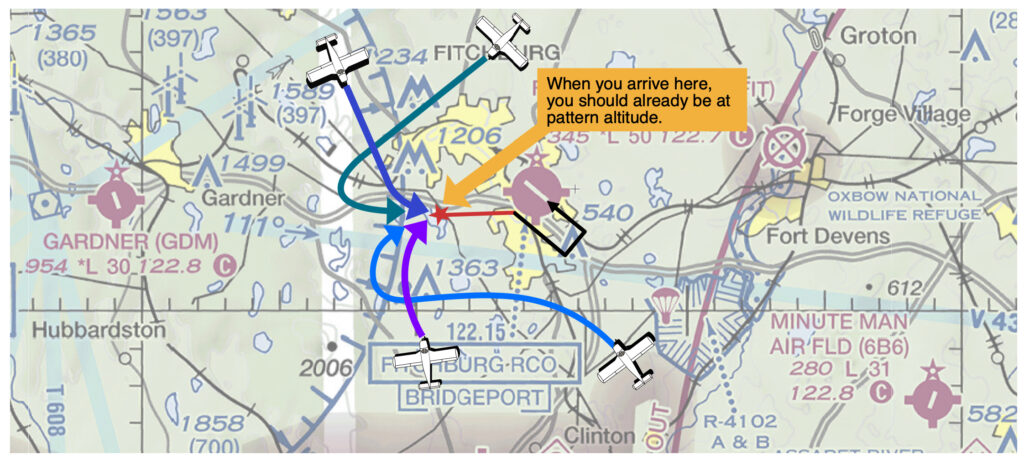
If approaching the airport from exactly the opposite side of the traffic pattern, you can overfly the field at 500 – 1,000 feet above the pattern altitude, stay at that altitude until well outside of the traffic pattern on the correct side (because some pilots/planes fly really wide patterns), and then maneuver to be at pattern altitude at that 45° entry point.
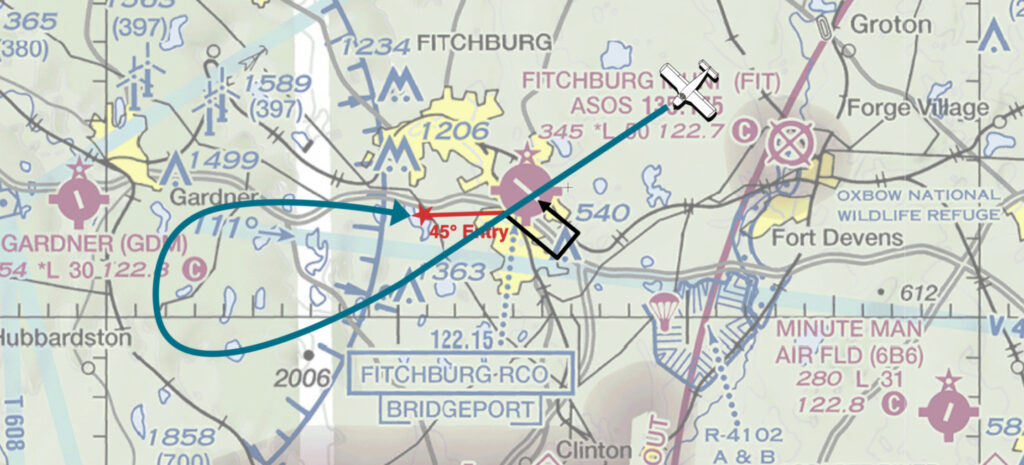
Example:
Pilot: “Fitchburg traffic, Warrior 123AB, is overflying the field at 2,000. Will maneuver to the 45° entry for the left downwind for runway 32, Fitchburg”.
Then
Pilot: “Fitchburg traffic, Warrior 123AB, is one mile to the west, entering on the 45° for the left downwind for runway 32, Fitchburg”
Customary traffic pattern altitude is 1000 feet AGL for piston aircraft, and 1500 feet AGL for turbines.
Crosswind entry
A “crosswind entry,” can be used if approaching from the opposite side of the airport. This involves descending to pattern altitude and flying directly over the departure end of the runway, then turning to enter the downwind.
Example:
Pilot: “Fitchburg traffic, Warrior 123AB, is entering on the crosswind for runway 32, Fitchburg”.
The least favorable way to set up to land is simply to fly straight in from miles away, though you will encounter people (mostly private jets) doing this. ALWAYS be sure to take a good look and clear the approach path before turning final!!!
Departing from an untowered airport
Look very carefully as you progress around the airport, go on to the runways, and depart.
Remember, people may not be making radio calls.
Make the following calls when:
- Entering a busy taxiway
- Crossing a runway
- Taking the active for takeoff
- Departing the area.
It’s still “You – Me – Where – What.” YOU in this case is the name of the airport, followed by the word “traffic.” Also END your transmissions with the airport name.
Example: Entering a busy taxiway
Pilot: Fitchburg traffic, Warrior 123AB taxiing from the tower ramp to runway 14, Fitchburg.
Example: Crossing a runway
Pilot: Fitchburg traffic, Warrior 123AB, crossing runway 2-20, Fitchburg.*
Example: Taking the active for takeoff
Pilot: Fitchburg traffic, Warrior 123AB taking runway 14 for departure to the northeast, Fitchburg.
Example:: Departing the area
Pilot: Fitchburg traffic, Warrior 123AB one mile to the south, departing the area to the northeast, Fitchburg.